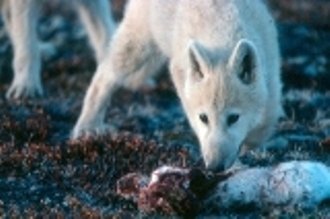
 |
|

Start Here: Predator/Prey -Predators-Prey Jump to:
Predator Module 1Predator Module 2Predator Module 3Download Entire Curriculum for Predator Download Dropbox and e-mail Dr. Packard to gain access to additional course materials |
Predator Module 3 |
Wolf & Prey PartnershipsMost of us think of wolves as the enemies of their prey, and do not realize that there is a delicate balance between predator and prey populations. Sometimes wolves may keep prey populations in check so that they do not "eat themselves out of house and home". At other times, prey populations erupt, eat up their plant food resources and the prey population crashes. The social behavior of wolves is adapted to such fluctuations. When food is plentiful, young wolves disperse early, find new mates and start new families. When food is scarce, young wolves that stay with the family group are more likely to survive than those that disperse. The size of the prey also makes a difference, because where only large prey are available, young wolves who disperse early are less likely to find food than those who live in food webs where dispersing wolves can catch small prey without the aid of family members. Learning Objectives:
Background:In the previous module about captive wolves, you learned how social space influences access to mates. In this module about wild wolves, you will learn how wolf social behavior influences access to food resources. Learn how small prey, like artic hare, may be easily shared between parents or between adults and pups. However, behaviors differ when the whole family participates in hunting large prey, like muskoxen. You will discover how the food begging behaviors of pups persist into adulthood and shape access by family members to a large carcass. The relations of wild wolves are shaped more by food delivery and food begging, than the interactions we watched in the previous module on captive wolves, who are fed by people. To learn more, here are some recommended sources:
Activities:Jump right in and learn by doing! You may choose to download this module so that you can work off-line. You may print it and write on it with a pencil, or use the Typewriter tool in Adobe Reader to do the activity on your computer. If this guided inquiry is not intuitive, we recommend reading the teacher's manual for some handy tips. If you are familiar with spreadsheets, you may choose to download the entire curriculum and use the Excel Workbook.
|
The information presented herein is for educational purposes only. Reference to commercial products or trade names is made with the understanding that
no discrimination is intended and no endorsement is implied. Unless otherwise noted, information provided by this page
does not represent the official views of Texas A&M University . |